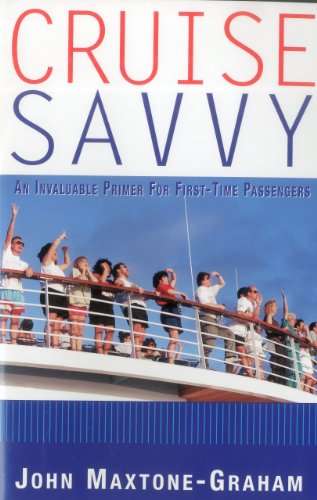Published by Sheridan House, 2000, softcover, illustrated, index, 182 pages, condition: as new.
An indispensable primer that will 'turn you on to shipboard.
Self-contained within and without, our ship bowls along imperturbably. Over each railing, we can watch sundered waters slip by, hissing where foam-flecked waves recoil from the implacable rampart of our moving hull. Overhead, funnel smoke shimmers and dissipates before the scouring ocean breeze and a dome of purest cerulean blue mates with surrounding horizon. Our perception of that fixed sea/sky margin is rhythmically at odds with the gentle, hypnotic lift and fall of the bow, motion as old a the waves. All is at peace. The vessel, her crew and her passengers are all functioning precisely as Triton and Poseidon intended they should. One sea day is glorious, two sublime, three, four, five, six, perfection
Every stop along a cruises itinerary is either a tendering portrequiring the use of the ships motorized tenders to achieve land from an offshore anchorageor a docking port, permitting swift, easy disembarkation directly onto the pier. The difference between merely tripping down the gangway as opposed to transferring into a small boat secured alongside an anchored ship is largely one of convenience. Beyond the harbor, out by the pilot station at the end of the channel, the mornings logistics are reversed. The pilot bids farewell and is escorted by a junior officer down a specially reserved elevator to the open shell door where the pilot boat awaits. He clambers down the Jacons ladder and, before vanishing below, waves up to the staff captain on the bridge wing. Pilots off, the latter imparts laconically and the ships hull is sealed against the moment of another pilots arrival in the next port.
As the pilot boat turns and speeds for shore, the convention of maritime leave-taking mandates a whistled exchange between two parting (or indeed, any passing) vessels. Three long, measured blasts, first form the pilot boat, then three in booming response from the larger ship. But that is not all: Tradition demands another final toota brief peck on the cheek, as it wereto complete the ritual.
Every floating object, whether aircraft carrier or length of driftwood, is subject in varying degrees to sea motion and aboard your cruise ship, there could be three different kinds of motion of which you will become aware. The first affects the vessels fore and aft axis, a lift-and-fall of the bow which sailors call pitching [] Pitching can occur at varying intensity. At its most serene, it is experienced as the majestic, up-and-down motion the bow makes when encountering long, almost imperceptible ocean swells .
The second distinctive motion you may encounter will be the hull rocking from side to side; this is called rolling. Although there is little any master can do to minimize pitching save slow down his vessel, he can reduce rolling to almost zero. Situated amidships on either side of the vessel are stabilizers, owerful steel fins that, when deployed on command from the bridge, project out from either side of the hull below the waterline. The third shipboard motion is a combination of pitching and rolling which sailors identify as scending.

